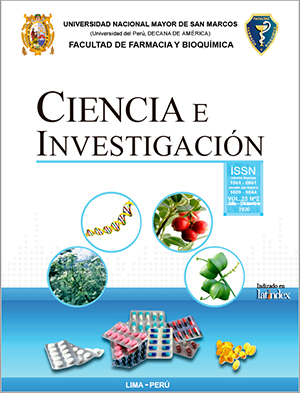Determination of arsenic and lead in lipsticks by atomic absorption spectroscopy that is expanded in Metropolitan Lima
DOI:
https://doi.org/10.15381/ci.v23i2.19379Keywords:
Arsenic, lead, Lipsticks, atomic absorption spectroscopyAbstract
In this research study, the concentration of arsenic and lead was determined in eight different brands of lipsticks that are marketed in Metropolitan Lima. Materials and methods Non-experimental cross-sectional design the analytical method used was atomic absorption spectroscopy with a graphite furnace, the analysis of variance was applied to compare multiple means (ANOVA) considering p <0.05 for significance and the Student t-test . Samples were collected randomly in shopping centers and analyzed at the Chemical Analysis Services Unit (USAQ). results, lead values range from 0 ppm to 71.96 ppm, the average concentration being 6.60 ppm, 12.5% of the samples exceed the maximum permissible limits (LMP) of 10 ppm recommended by the Food and Drug Administration (FDA), Values for arsenic range from 0 ppm to 16.59 ppm, the average concentration is 3.34ppm, and 40.6% of the total samples exceed the maximum permissible limits (MPL) of 3 ppm established by the FDA. Conclusion, the average concentration of lead in lipsticks does not exceed the LMPs. values recommended by the FDA, while the average value of arsenic does exceed it.
Downloads
Published
Issue
Section
License
Copyright (c) 2020 José A. Llahuilla Q., Lizabeth S. Laguna G., Edson D. Ricaldi C.

This work is licensed under a Creative Commons Attribution 4.0 International License.
LOS AUTORES RETIENEN SUS DERECHOS:
- Los autores retienen sus derechos de marca y patente, y tambien sobre cualquier proceso o procedimiento descrito en el artículo.
- Los autores retienen el derecho de compartir, copiar, distribuir, ejecutar y comunicar públicamente el articulo publicado en la Revista Ciencia e Investigación (por ejemplo, colocarlo en un repositorio institucional o publicarlo en un libro), con un reconocimiento de su publicación inicial en la Revista Ciencia e Investigación.
- Los autores retienen el derecho a hacer una posterior publicación de su trabajo, de utilizar el artículo o cualquier parte de aquel (por ejemplo: una compilación de sus trabajos, notas para conferencias, tesis, o para un libro), siempre que indiquen la fuente de publicación (autores del trabajo, revista, volumen, numero y fecha).






